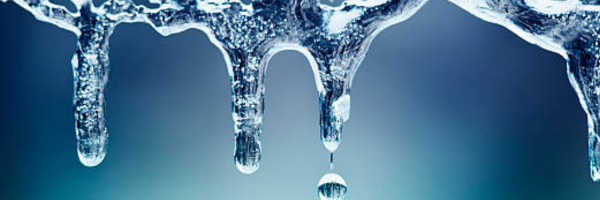Why is salt used on icy roads?
Grade 5
Presentation
No video provided
Hypothesis
Introduction
Ice melts when it gets warm, but different things can make it melt faster or slower.
In this experiment, we will test different substances like salt, sugar, baking soda, baking powder, sand, pepper, hot water, and tap water to see which one melts ice the fastest.
This is important because people use salt to melt ice on roads in winter, and scientists study ice melting to learn about weather and the environment.
By doing this experiment, we can learn more about how ice changes and why some substances make it melt faster than others.
Question
Which substance melts ice the fastest: salt, sugar, baking soda, baking powder, sand, pepper, hot water, tap water, or no substance at all?
Hypothesis
If different substances are placed on ice cubes, then salt and hot water will melt the ice the fastest because it lowers the freezing point of water, causing the ice to melt quicker.
Research
1. What is freezing point?
Freezing point is the temperature at which a liquid turns into a solid. When a liquid gets cold enough, its molecules slow down and stick together forming a solid.
2. What is the melting point?
Melting point is the temperature at which a solid turns into a liquid.For example, ice melts into water at 0 degree C (32 degree F)
3. What is freezing point depression?
When a substance (like salt) is added to a liquid (like water) it lowers the freezing point.
4. What is solvent?
A liquid that dissolves something.Water is the most common solvent because it can dissolve many things, like sugar or salt.
5. What is a solute?
The substance that gets dissolved in a solvent.
6. What is phases of matter?
The different forms that matter can take. The main ones are:
- Solid - Has fixed shape and volume
- Liquid - Takes the shape of its container but has fixed volume
- Gas - Spreads out to fill its container and doesn't have a fixed shape or volume
Variables
• Independent Variable:
The substance placed on the ice cube (salt, sugar, baking soda, baking powder, sand, pepper, hot water, tap water, and no substance).
• Dependent Variable:
- The time it takes for the ice to melt
- The amount of ice melted
• Controlled Variables:
- Same size and shape of the ice cubes
- Same amount of substance (1 teaspoon/5 mL)
- Same room temperature
- The observation time (1 hour).
Procedure
1. Prepare the Cups – Place 9 cups on a flat surface. Add one ice cube to each cup. Make sure all ice cubes are the same size.
2. Add the Substances – Add 1 teaspoon (5 mL) of each substance onto an ice cube in a separate cup. Leave one cup as the control (no substance added).
3. Start the Timer & Observe – Set a timer and observe the ice cubes every 10 minutes. Record any changes in melting.
4. Form Your Hypothesis – Before looking at the results, write down your hypothesis about which substance will melt the ice the fastest.
5. Shake the Cups (After 30 Minutes) – After 30 minutes, shake the cups to mix the substances with the melted water. Continue recording observations.
6. Measure & Compare (After 1 Hour) – After 1 hour, measure the amount of melted water in each cup. Compare the results and determine which substance melted the ice the fastest.
7. Draw a Conclusion –Write your conclusion about which substance worked best and why.
Observations
SET UP
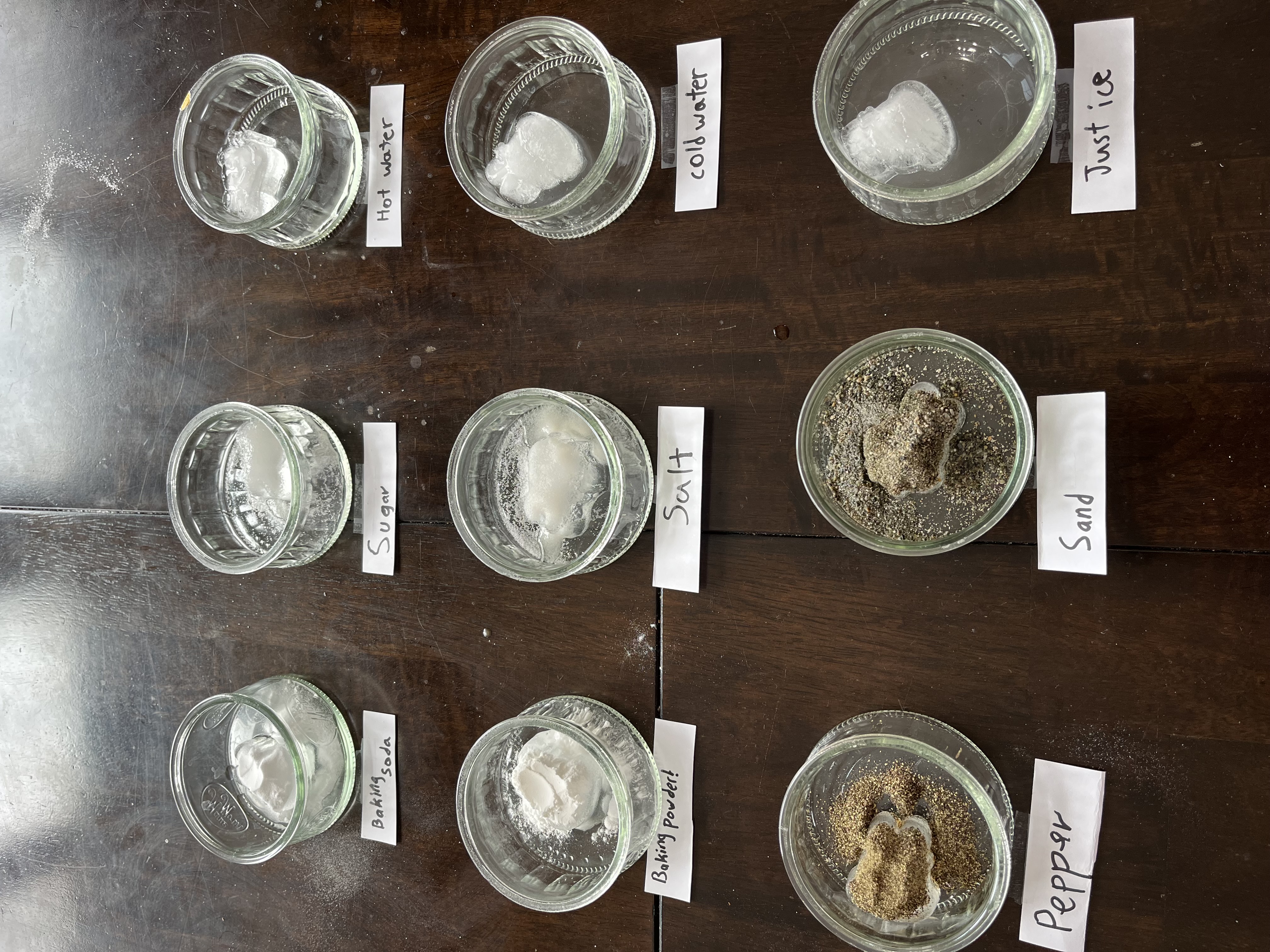
10 MIN LATER
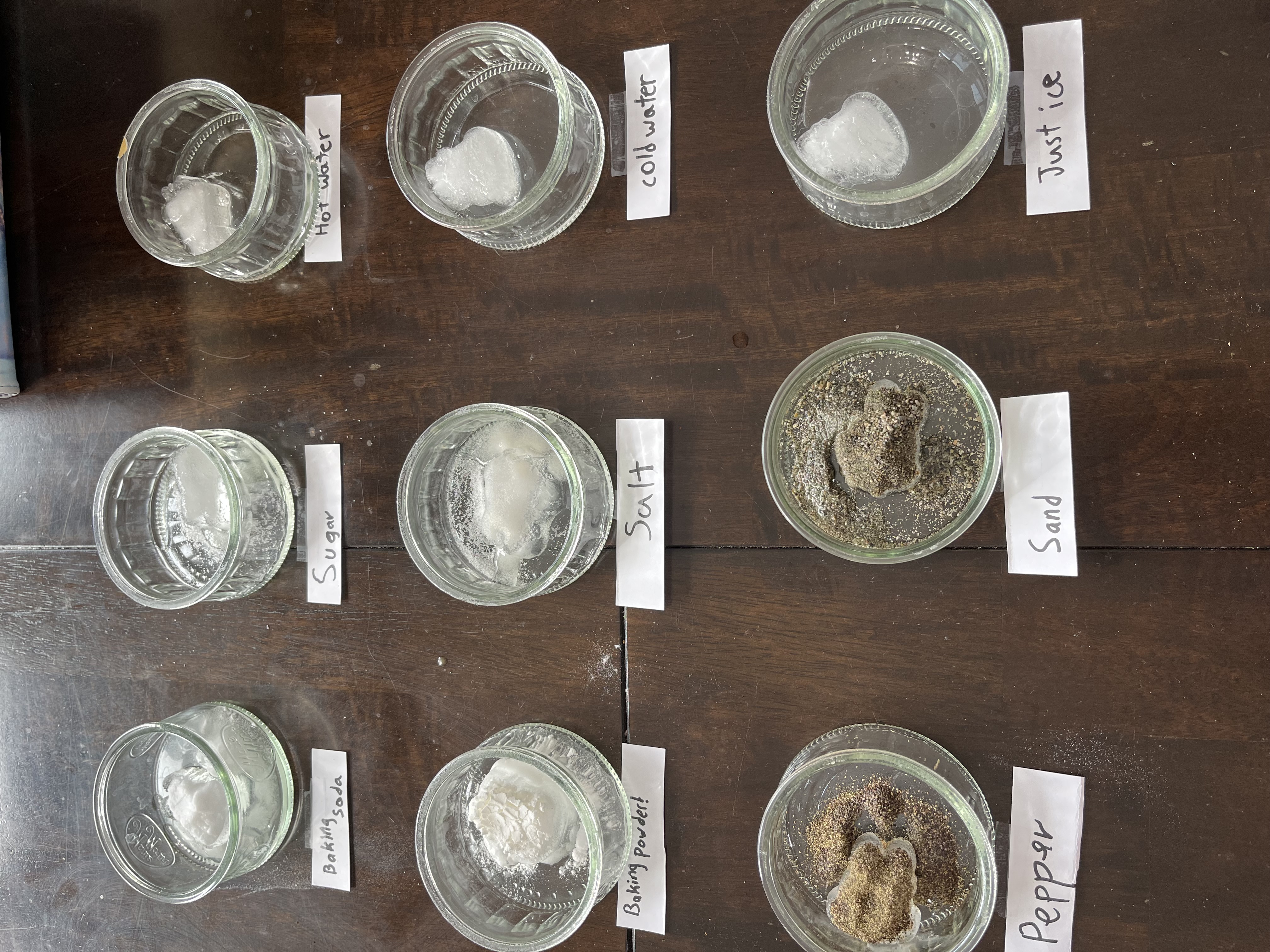
20 MIN LATER

30 MIN LATER
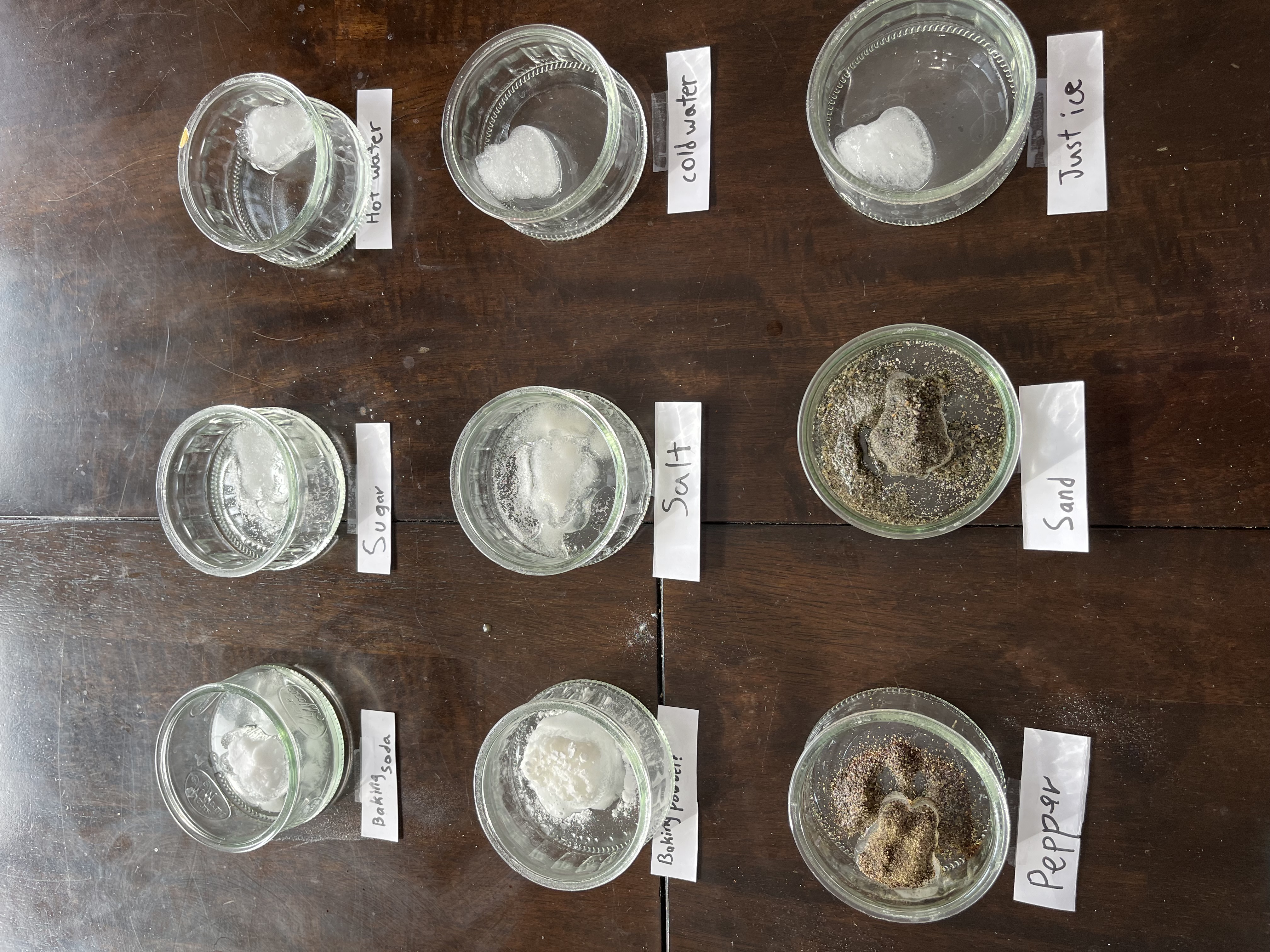
1 HOUR LATER
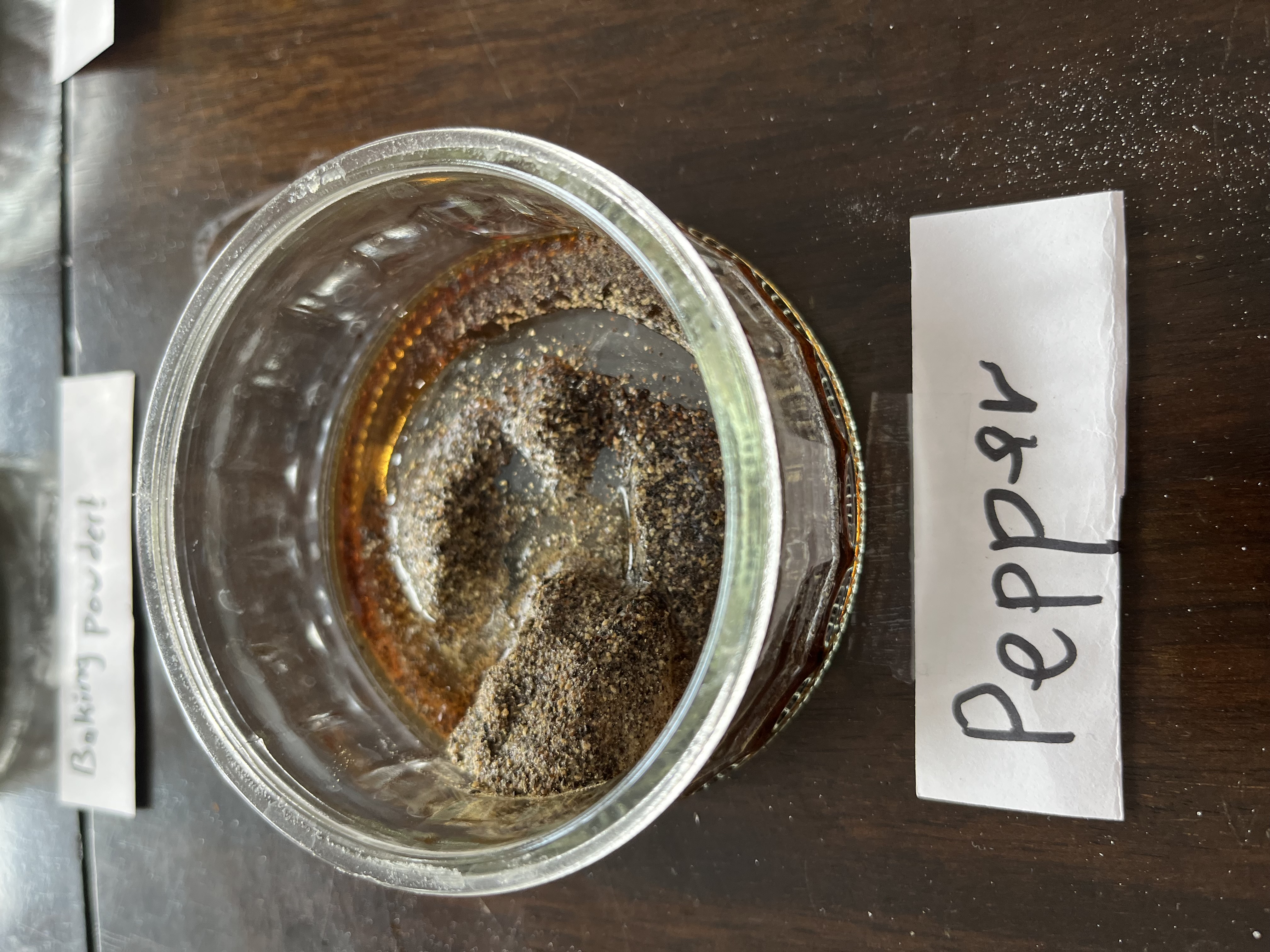
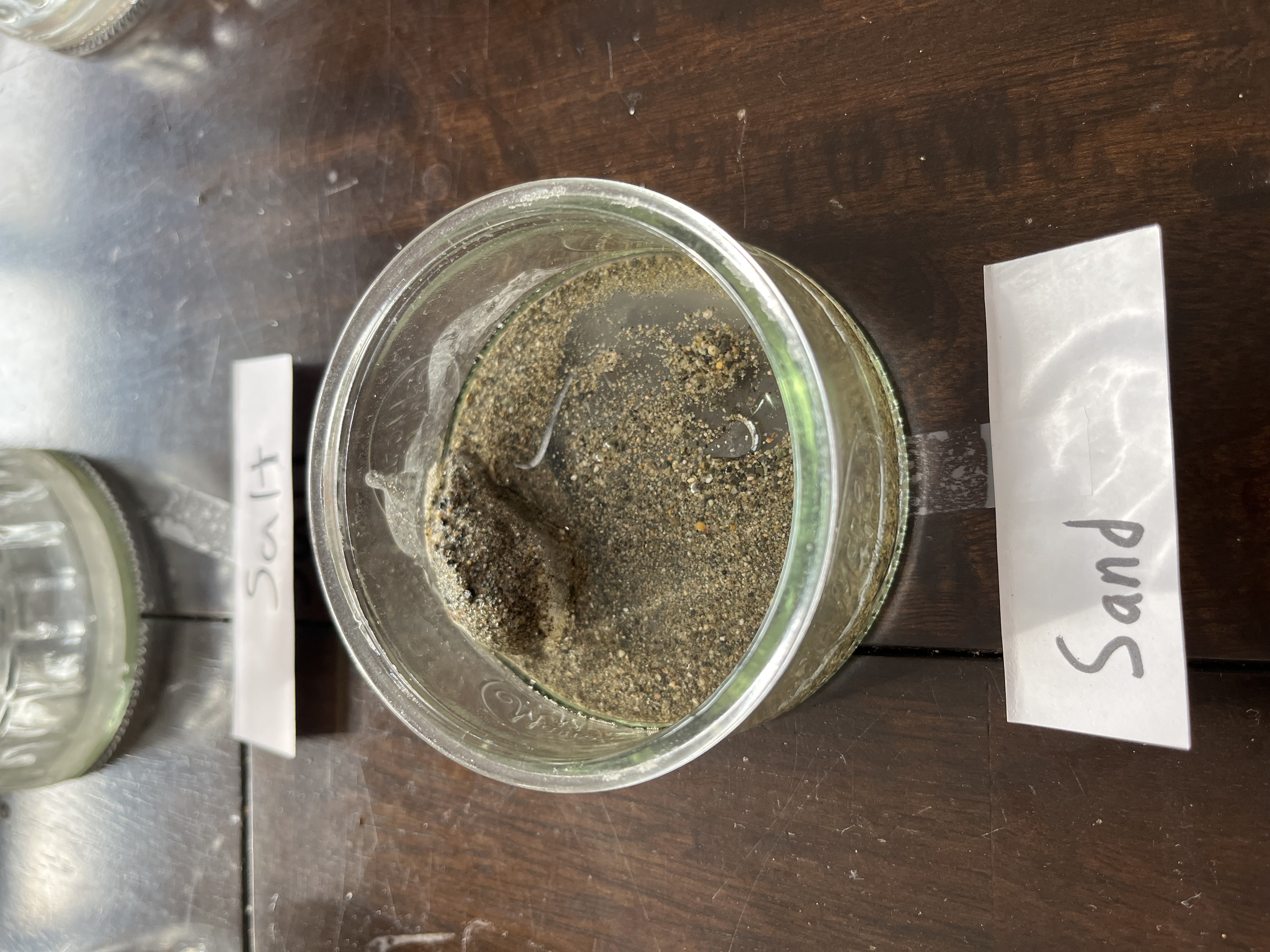
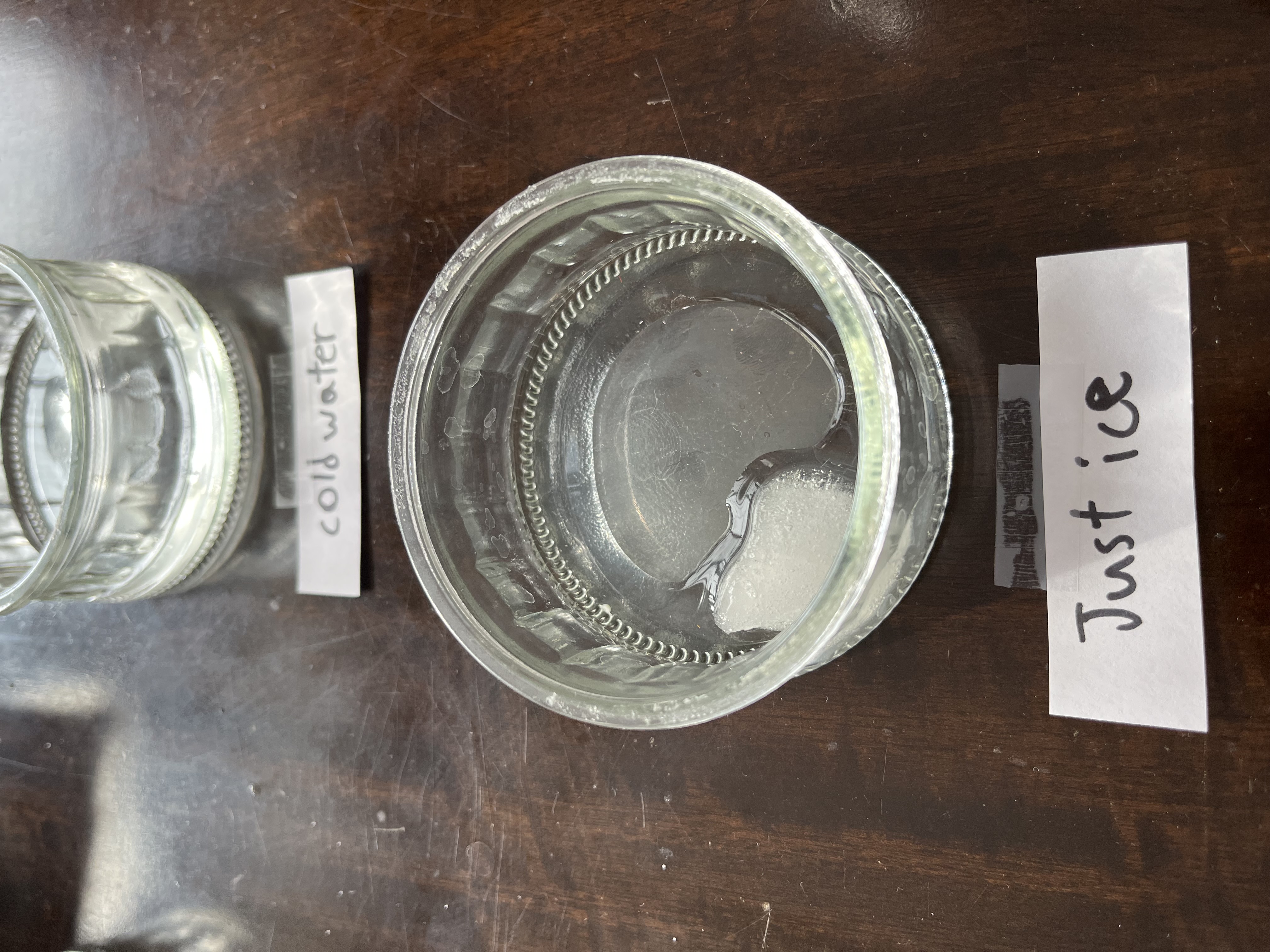
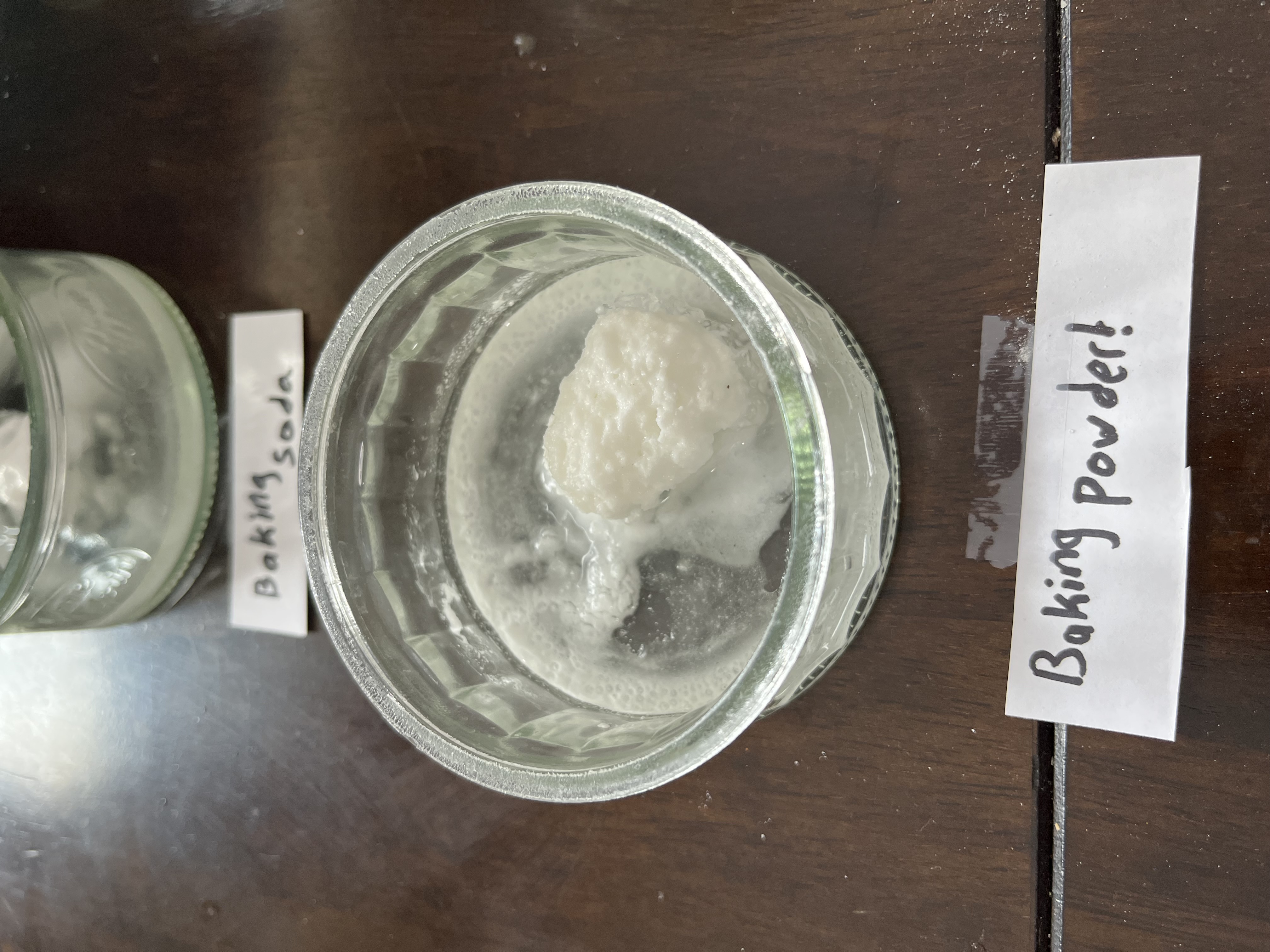
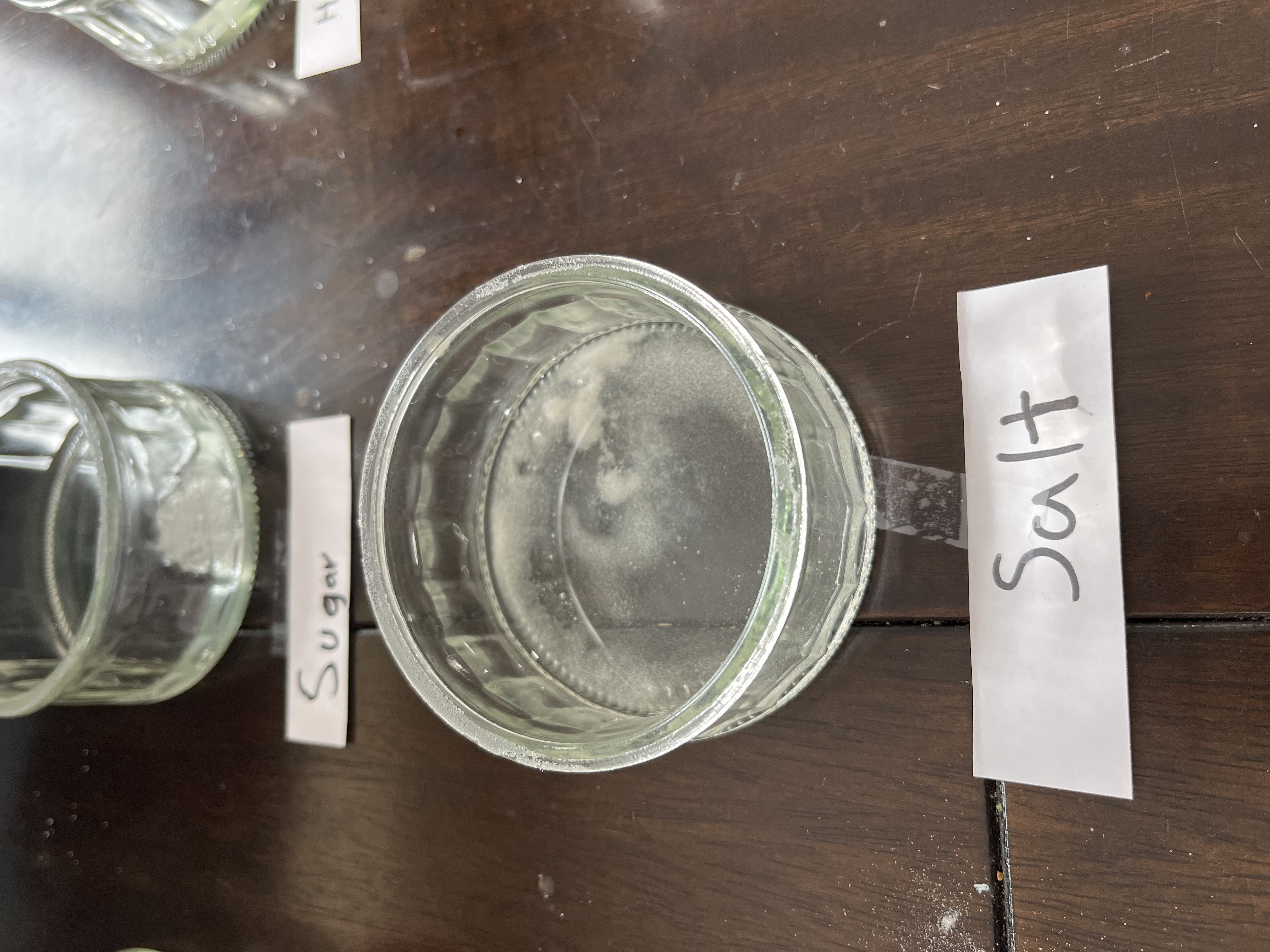
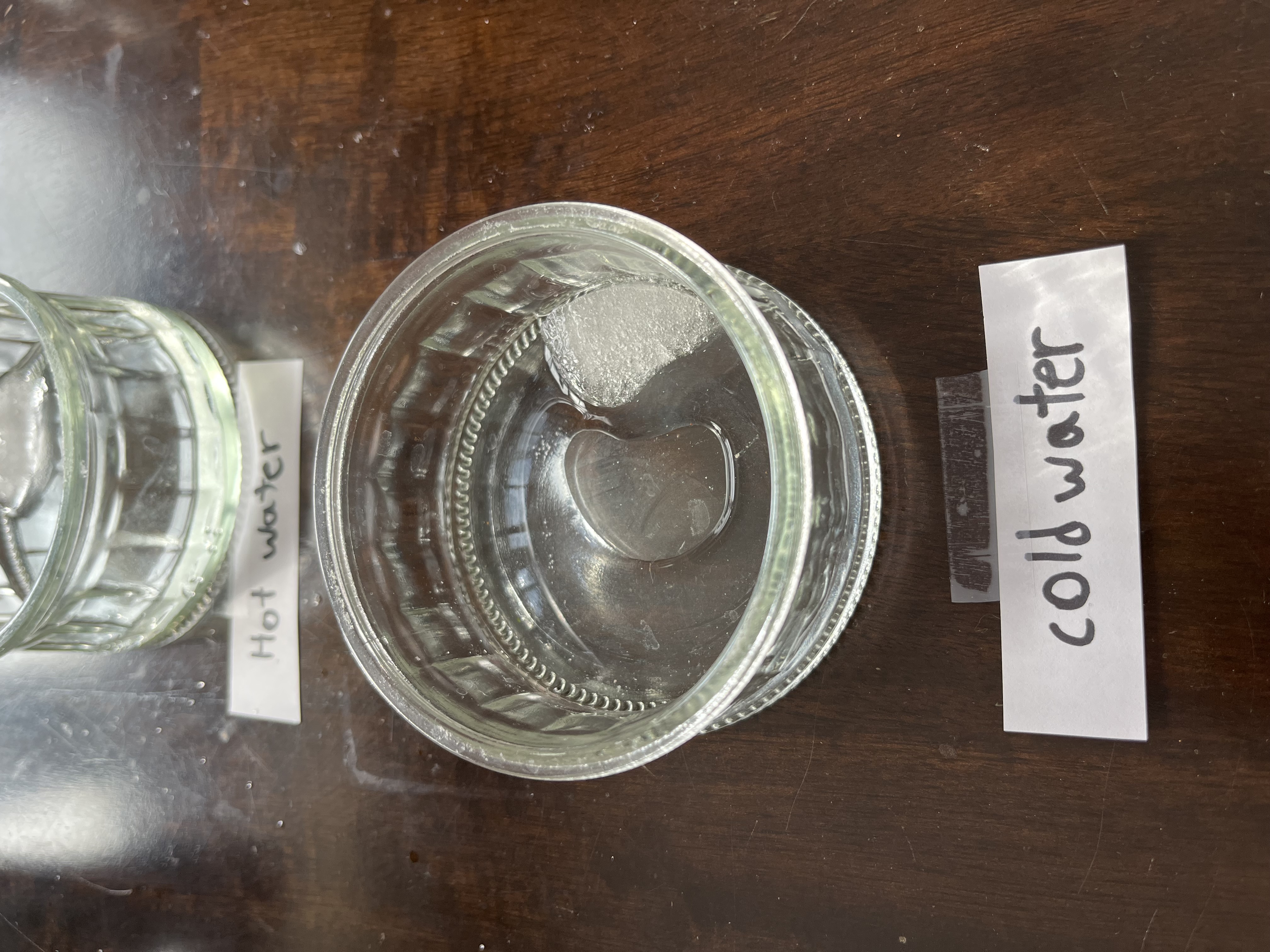
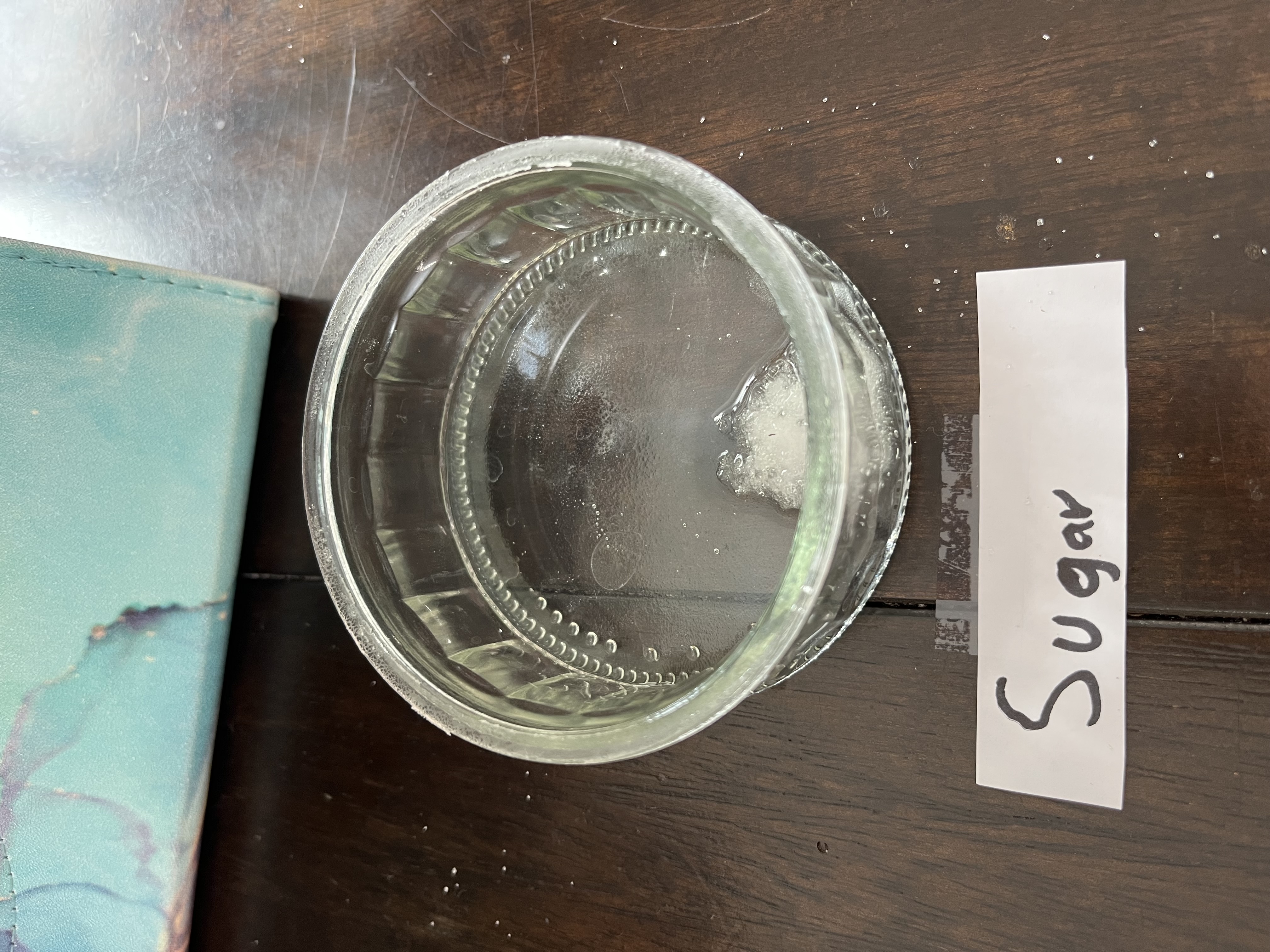
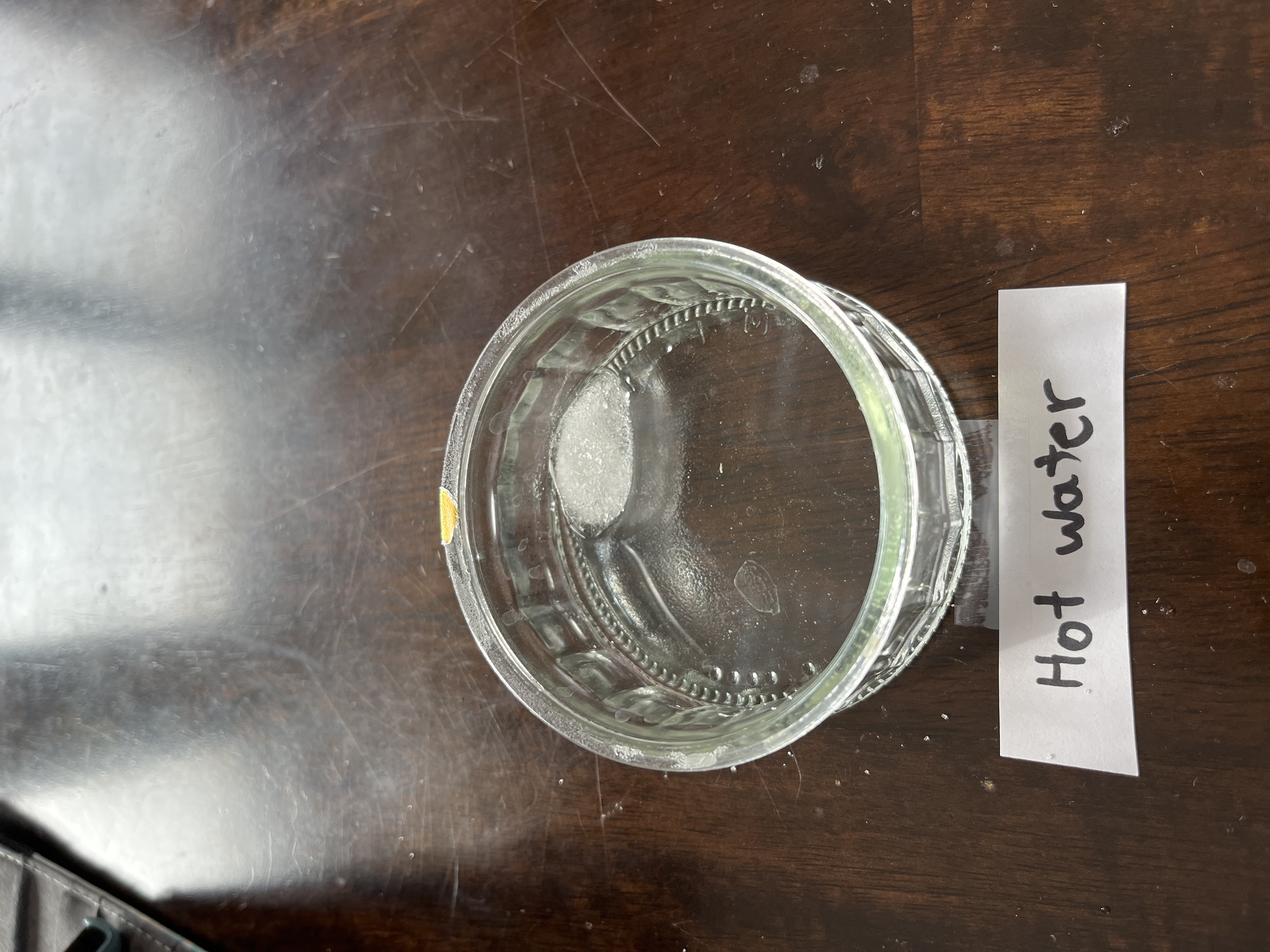
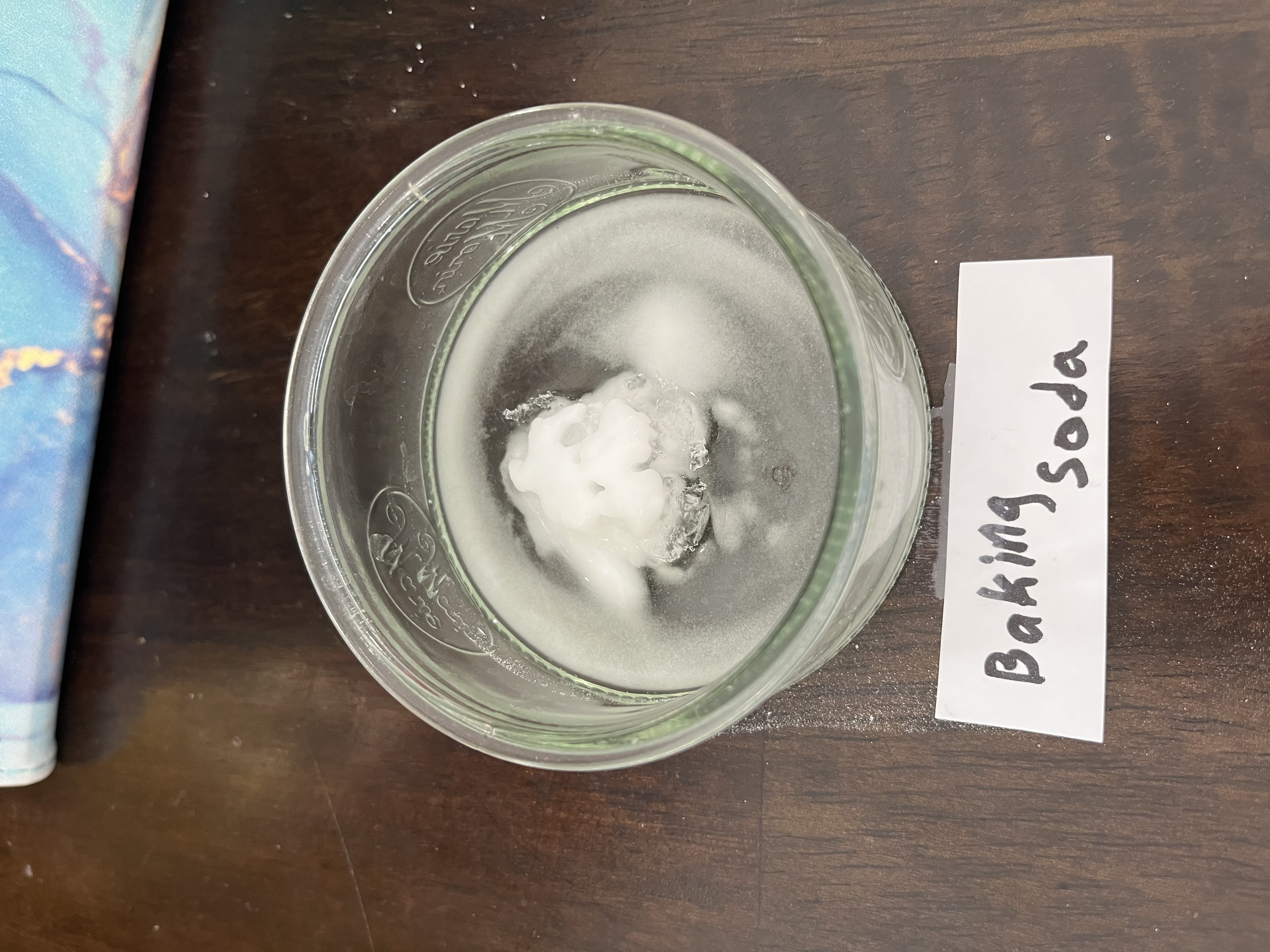
RESULT
| Variables | ice cube weight | melted water | remaining ice |
|
Baking soda |
14g | 11g | 3g |
| Sugar | 14g | 10g | 4g |
| Hot water | 14g | 13g | 1g |
| Baking powder | 14g | 9g | 5g |
| Salt | 14g | 14g | 0g |
| Tap water | 14g | 11g | 3g |
| Pepper | 14g | 8g | 6g |
| Sand | 14g | 9g | 5g |
| Just ice(control) | 14g | 10g | 4g |
When we put baking powder on the ice cube, the baking powder started bubbling.
When we put baking soda on the ice cube, the ice cube got stuck on the bottom of the container.
Before the time reached 30 minutes, the ice with the sugar was melting the fastest but after the time reached 30 minutes, the ice cube with the salt began to melt the fastest.
The ice cube with the salt completely melted the fastest, timing 53 minutes, 52 seconds.
Analysis
Our experiment showed that different substances affect how fast ice melts. The two substances that melted the ice the fastest were salt and hot water. Here’s why:
1. Salt: The Fastest Melting Agent
Salt was the most effective at melting ice because it lowers the freezing point of water. Normally, water freezes at 0°C (32°F), but when salt is added, it lowers this temperature. This means that ice needs to be much colder to stay solid, causing it to melt quickly. This is why salt is spread on roads in the winter—it helps prevent ice from forming and makes existing ice melt faster.
2. Hot Water: Adding Heat to Melt Ice
Hot water was also very effective because it directly added heat energy to the ice, speeding up melting. Ice melts when it absorbs heat, and since hot water has more heat than the ice, it quickly transfers that heat, making the ice melt much faster than substances like sugar or baking soda.
3. Other Substances: Moderate or No Effect
• Sugar and Baking Soda: These substances had some effect on melting but were not as strong as salt. This is because they don’t significantly lower the freezing point of water. They might have helped a little by mixing with the water and changing how it interacts with the ice.
• Sand and Pepper: These did not help melt the ice because they do not dissolve in water or change its freezing point. Instead, they just sat on top of the ice without causing any major melting.
• Control (No Substance): The ice in the control cup melted the slowest because nothing was added to help speed up the melting process.
Conclusion
Our hypothesis was correct— the salt melted the ice the fastest, timing 53 minutes and 52 seconds.
This is because salt lowers the freezing point of water, causing the ice to turn into water more quickly.
Hot water also melted the ice fast for few minutes but after 10 minutes the water cooled down.
This experiment helps explain why salt is used on roads in the winter—it makes ice melt faster and prevents dangerous slippery conditions. It also shows how different substances interact with ice in real-life situations.
Application
This experiment helps us understand how different substances affect the melting rate of ice. This experiment is useful in real life because:
• Winter Road Safety: Salt is used in winter to melt ice on roads and sidewalks.
• Use for Cooking - People use salt in cooking to change how ice and water react.
• Environmental Study - Scientists study ice melting to understand the environment and climate change.
Sources Of Error
Amount & Time:
- We had nine substances to put on the ice but we could've had more than nine substances to put on the ice to make it melt
- We also could've had spend some more time seeing if which ice melts the second fastest or the last
Some things that might have affected the results:
• Unequal Ice Cube Sizes: The ice cubes might not be the same size
• Uneven substances distribution: Some substances might not have been spread evenly on the ice.
• Temperature Change: If the room temperature changed during the experiment, it could affect the melting rate.
• Measurement Errors: There might be small mistakes in measuring the melted water.
• Shaking Variability: The shaking of the cups might not have been the same for each one.
Citations
- Science New Explorer. “What makes ice melt fastest” https://www.snexplores.org/article/experiment-what-makes-ice-melt-fastest
- Destructive Creativity : https://youtu.be/gx9Hi6d1Tfs?si=xrtdNxUQIqAWnEFd
- Britannica. “Why does salt melt ice?” https://www.britannica.com/story/why-does-salt-melt-ice
Acknowledgement
We would like to express our gratitude to the following people for their support in completing this project:
• [Mrs. Karen Spelay] for guiding us through the scientific process and providing helpful feedback.
• Our parents for helping us gather materials and set up the experiment.
Thank you to everyone who helped make this project a success!

